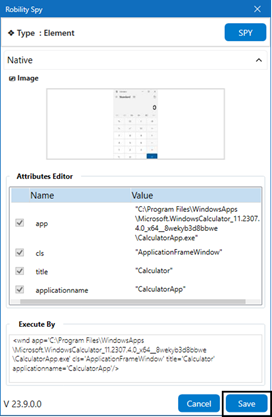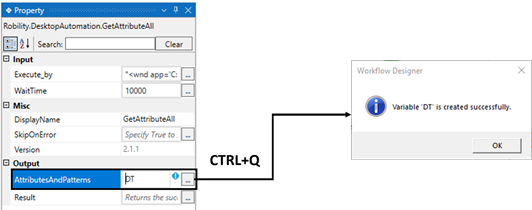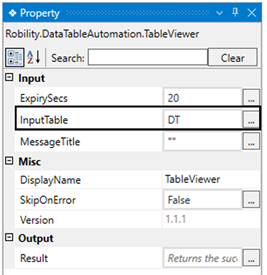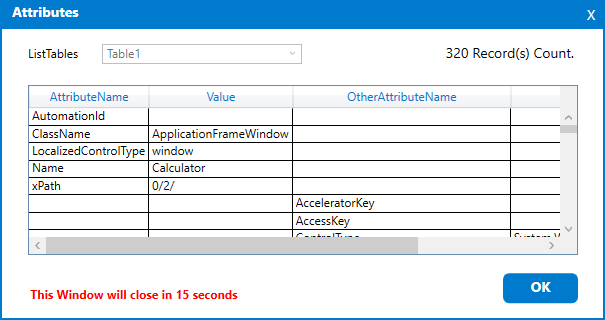This activity helps to extract all the “Attributes” and its corresponding “Values” from
the detected application on the desktop.
The extracted attributes can be used in subsequent activities for further processing.
It also helps to validate the element before performing any action.
Technical Reference
|
Input |
DelayAfter: It assists the user to add a delay before initiating subsequent activities. |
|
|
DelayBefore: It assists the user in adding a delay before starting the execution of the activities. |
||
|
ExecuteBy: Gets auto filled once the "Active Application" is selected. This contains the set of attributes for the specific detected element. |
||
|
WaitTime: It helps the user to add a delay to start the execution of the further activity. The format of the delay here is milliseconds. By default, it will be set to 10000. When the option is left blank, no delay is considered. |
||
|
Misc |
DisplayName: Displays the name of the activity. The activity name can also be customized to help in troubleshooting. |
|
|
SkipOnError: Specify the "Boolean" value as "True" or "False."
True: Continue executing the workflow regardless of any errors thrown. False: Halt the workflow if it encounters any errors. None: If the option is left blank, the activity will, by default, behave as if "False" were chosen. |
||
|
Version: It indicates the version of the feature being used. |
||
|
Output |
AttributesAndPatterns: This parameter helps to view the output of the activity, displaying all “Attributes” with their corresponding values from the detected application. It returns the values in a “Datatable” data type. |
|
|
Result: It provides the ability to view the execution status of the activity. It returns values in "Boolean."
True: Indicates that the activity has been executed successfully without any errors. False: Indicates that the activity has been unsuccessful due to an unexpected error being thrown. |
* Represents mandatory fields to execute the workflow
Here’s an example of how the “GetAttributeAll” activity works –
In the following example, I am going to automate with the “Calculator” application to
extract the attributes for every element available on the application.
1. Drag and drop the “GetAttributeAll” activity to the workflow.
2. This activity helps to extract all the element’s attributes that are available in the
desktop application.
3. Here I am going to extract the attributes from the “Calculator” application.
a. Now, double clicking on the activity to choose the “Select Element” hyperlink
to detect the element.
b. Navigating to the “Calculator” application which has already been kept
opened on the desktop.
c. Spying over the application to detect it.
d. Clicking on it to select the elements to automate.
e. Now, the “Robility Spy” window appears on the screen to choose the “attributes”
from the element editor window.
f. Here, by default all the attributes will be chosen, and we will only be able to
edit the values from the chosen attribute.
g. Clicking on the “Save button” to save the detected element and its attributes
to the activity.
h. Navigating to the “AttributesAndPatterns” property in the output section
of the activity.
i. here, I am going to declare a variable here to view it in a table format.
ii. There are two ways to create a variable-
iii. Method 1 – Click on the " AttributesAndPatterns" property within the
"GetAttributeAll" activity and enter the variable name. In this case, we are using
" DT." Then, press "Ctrl+Q," which is a shortcut key to create a variable.
iv. Method 2 - Click on the Variables pane and enter the name " DT " Then, in the
"Variable Types" column, select "Browse for Types" from the dropdown menu.
v. The .Net window for data types will appear on the screen, enter the type
name as “System.Data.Datatable” and then click on “OK” button.
i. Finally, placing the “Table viewer” activity next to the “GetAttributeAll” activity.
i. Here I am using this activity to view the output from the variable declared in the
“Data_table” property in the “GetAttributes” activity. It helps to view the output in
a table format.
4. Navigating to the “ InputTable” property in the “Table viewer” activity.
5. Here I am providing the input table as “ DT” declared in the output of the
“GetAttributeAll” activity.
i. Moving to the “MessageTitle” property to set the title for the table.
6. Here I am specifying the title as “Attributes”.
7. Now, I have executed the workflow to view the output.
(Below is the sample of the output of the activity viewed in a table format).








